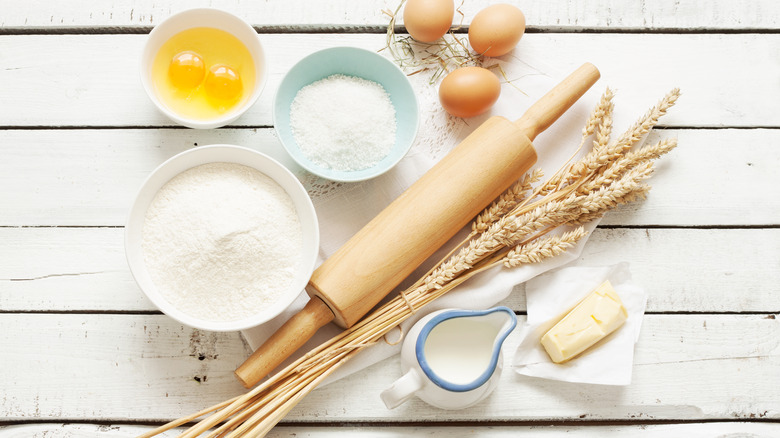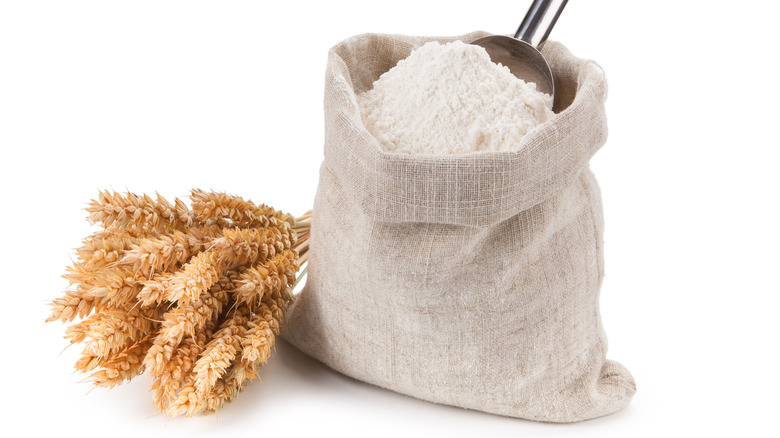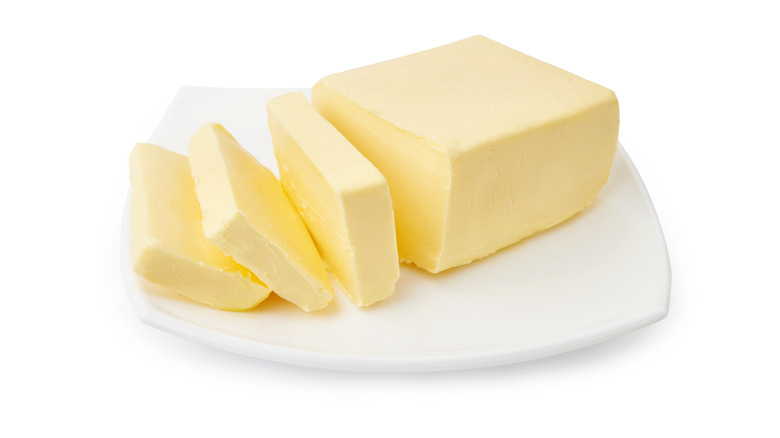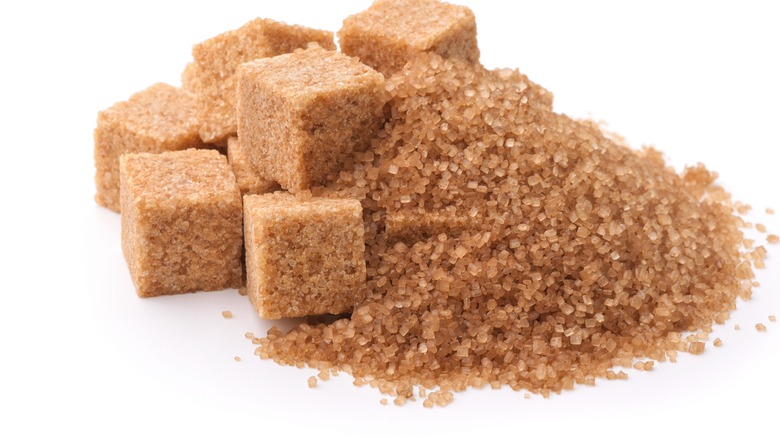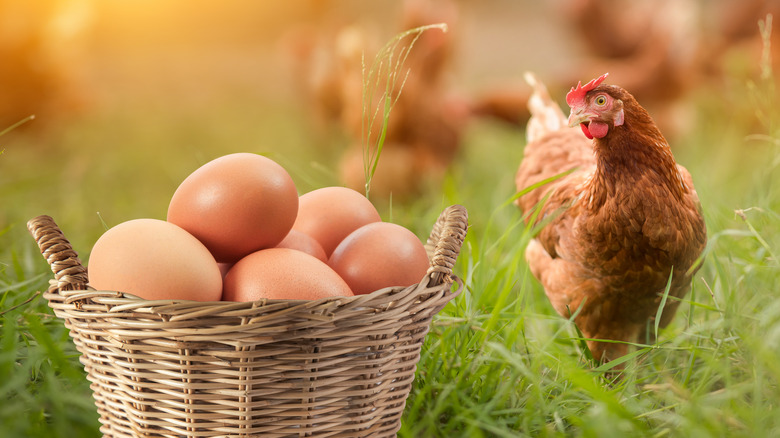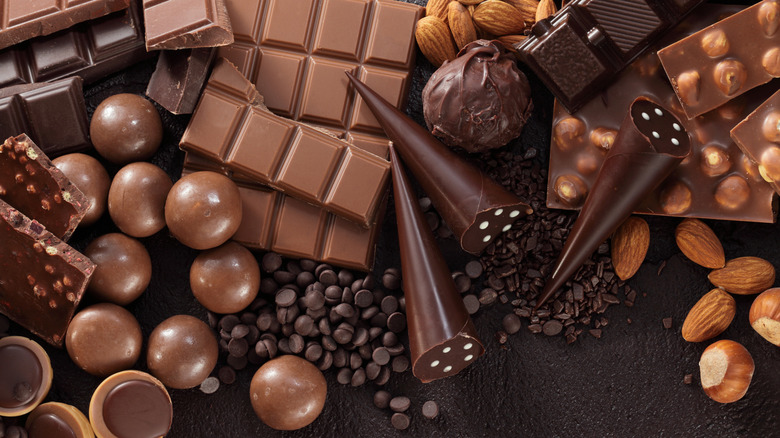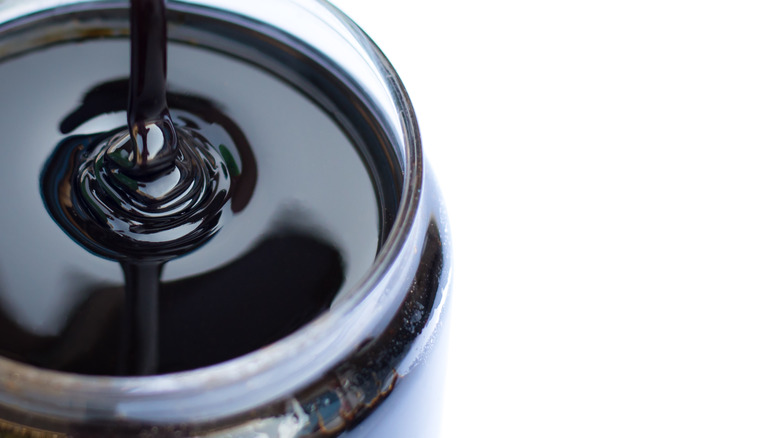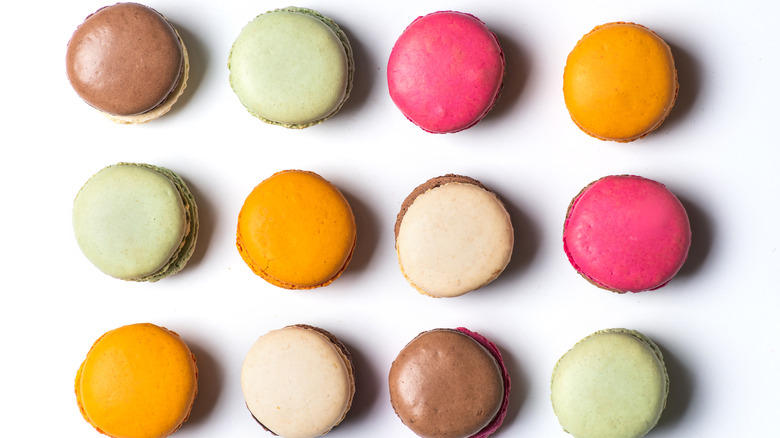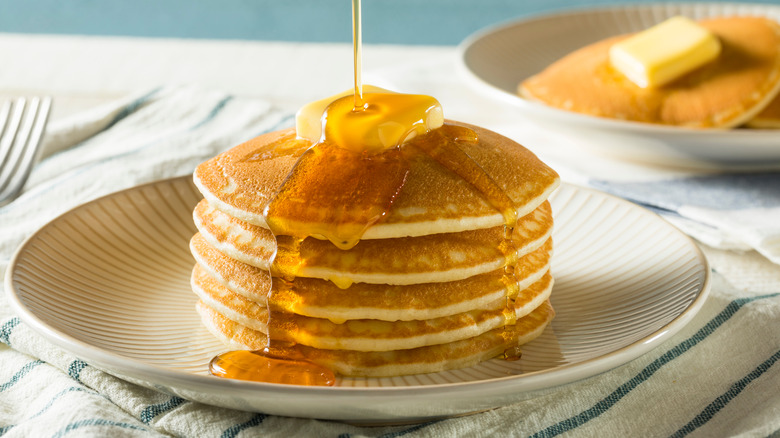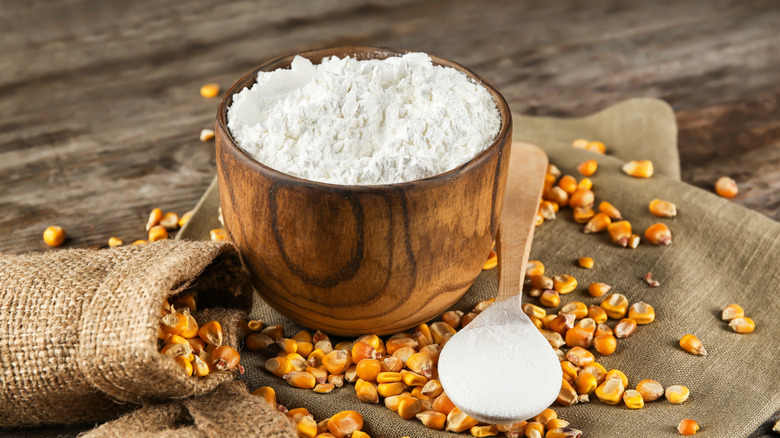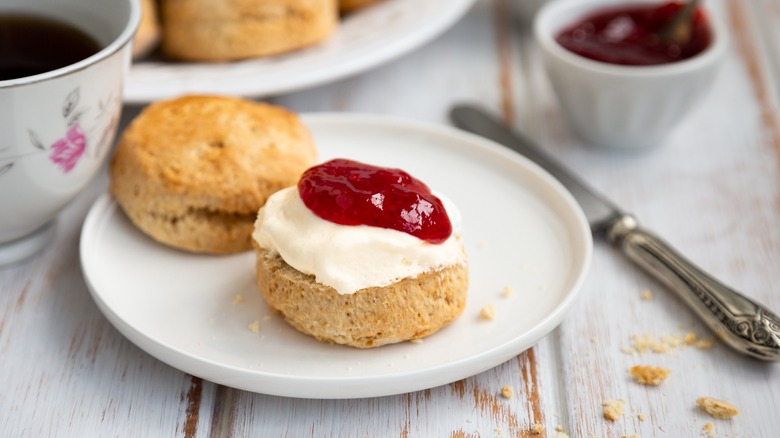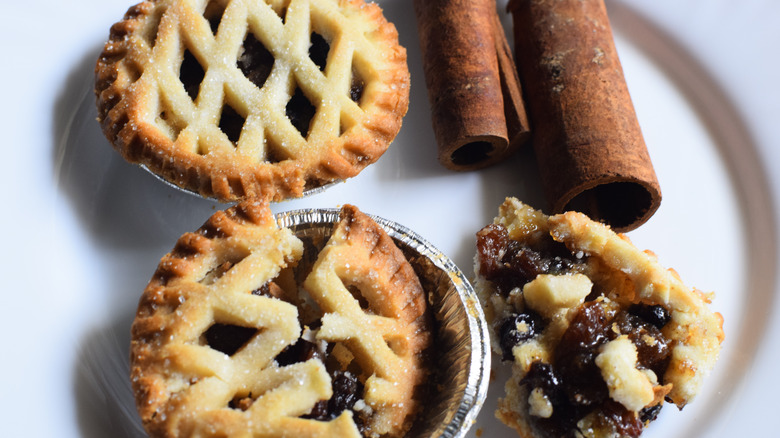Baking Ingredients That Are Totally Different In Britain Vs America
In the world of home baking, knowing your ingredients well is key to creating masterpieces in the kitchen. You need to be familiar with the foods in your pantry and rely on them to give you results every time, as any variation in the quantity and ratio of ingredients could result in a culinary catastrophe.
The British take their baking seriously, and the success of The Great British Baking Show suggests that we are willing to follow in their footsteps. With our shared language, you may assume that baking ingredients in Britain would be identical to those in the States, but that is often not the case. From muscovado sugar to clotted cream and golden syrup, navigating the water of British baking may be more challenging than you would expect.
Whether you are planning to bake during a trip across the Atlantic or simply want to follow British recipes you have found online, understating the subtle difference between the ingredients is crucial. Join us as we explore the baking ingredients that are not quite what they seem and discover the familiar alternatives you can use instead.
Flour
When it comes to British flour, it is not simply a case of choosing between all-purpose and self-rising, and if you do opt for all-purpose, it won't be the same as you are used to here! The British have a number of different flours that are commonly available in supermarkets, and using them interchangeably will result in some disappointing pastries.
The main difference between different types of flour is the protein content, which in turn will affect the amount of gluten. All-purpose flour in Britain will have 9-10% protein on average, compared to 11-12% in the US. This may not seem like a huge difference, but a small change in gluten content can have a drastic effect on the outcome of baked goods. A higher gluten content creates baked goods with lots of holes, whereas lower gluten means a denser texture. Bleached flour is also banned in Europe due to the possible adverse health effects, meaning the color of British flour may be slightly different, too.
For a higher protein content in Britain, opt for a strong bread flour with around 12% protein. This is made from 'hard' wheat that is closer to the wheat grown in North America. However, if you are looking for a replacement for cake flour, your closest match is probably plain flour, though it will be slightly higher in protein. Self-raising flour is also very common in Britain, so be sure to check before adding in any raising agents.
Butter
If you are baking in Britain and in need of some butter, you may be relieved to find it looks reassuringly similar. However, appearances can be deceptive, and British butter is slightly different compared to its US counterpart. The main difference is the fat content – butter in the states generally contains about 80% fat, but in the EU and Britain, butter has at least 82% fat and as much as 90%.
This extra fat means richer pastries, flakier crusts, and a generally more indulgent flavor and texture. Since it affects the texture of baked goods, substituting British butter for your usual block may cause problems when baking.
The fat content is not the only difference between the butters. Since British butter is generally churned for longer and has cultures added to allow it to ferment, the flavor is affected, too. As a result, you may find the flavor more tangy than you are used to. This does mean that dishes where butter is the star, such as shortbread, will have a distinctive flavor when made with British butter, one you may actually come to prefer.
If you're making a US-based recipe with British butter, you will need to make some alterations if you want to conserve the texture of the finished dish. If there are other fats in oils in the dish, reducing the amounts of them should compensate for the higher fat content of the butter. Alternatively, find a British version of the recipe online that will accommodate the additional fat.
Sugar
When it comes to sugar, most of us would wonder whether to use white or brown, but in Britain, it's a much more elaborate decision. British recipes regularly call for one of many varieties of sugar, including caster sugar, light and dark muscovado, icing sugar, and granulated. Without knowing which of these most closely resembles the sugar you are used to, the texture of your sweet treats may be affected.
Caster sugar is commonly used in British baking, in cakes and meringues, since it dissolves well. It is finer than our granulated sugar and is a close match for Baker's sugar. Icing sugar is finer still and is used, as the name suggests, for making icing as well as buttercream.
Muscovado sugar comes in two forms, dark and light, depending on how much molasses it contains. It has a deep, satisfying flavor and is used in darker cakes such as gingerbread and fruitcake. Dark muscovado contains twice as much molasses as light, so it is important to choose the correct option for your recipe.
If you are looking for a sweet finish for your cake, demerara sugar should do the trick. It has a lower molasses content than Muscavdo but can still add a shiny brown crunch to your pastries. Navigating the world of British sugar may take some working out, but it will be worth it to appreciate the difference that the right type of sugar can make to your signature desserts and cakes.
Eggs
Eggs are the often undervalued lynchpin of the baking world, and British eggs have a few crucial differences from their American counterparts. For the most part, baking involves hen's eggs, though duck and goose eggs are available too, especially directly from farms.
The first noticeable difference is the size of the eggs. The way that eggs are sized is different between the two continents, so a large egg in the UK is the same size as an extra-large one here. You may think this won't make a difference to your baking, but even a small change in the quantity of eggs will affect the moisture content and texture of your baked goods, so you should adapt the number of eggs you use to compensate.
Storage of eggs in Britain is also different, and you may be surprised to see them out of the refrigerator in the grocery store. While it may be unsettling to see cartons of eggs next to dried foods, there is no need to worry. Room-temperature eggs are at a much higher risk for salmonella, meaning refrigerating them in the USA is crucial. However, in Europe, chickens are vaccinated against salmonella, and as a result, cases of the disease have plummeted. As long as the eggs bear the British Lion stamp, they can be safely stored in a cool environment with little risk of illness. They can also be eaten raw, even by children and pregnant women, though this is unlikely to affect your baking practices.
Chocolate
One of the most indulgent and delicious baking ingredients is undoubtedly chocolate, but debate rages over American and British chocolate and which one can take the crown of chocolate champion. In truth, neither one is better, but there is a distinct difference between the two that can have an effect on your baking if you are not aware.
The most marked difference is in the cocoa content. Cacao – the raw form of cocoa – is a superfood packed with antioxidants and minerals and is what gives chocolate its identity (via Healthline.) In the USA, cacao levels in chocolate must be at least 10%, whereas in Europe and, therefore, Britain, chocolate must have a minimum of 20% cacao. This results in a marked difference in the flavor of the two types, with British chocolate having a much richer flavor and texture. Cadbury, the leading chocolate brand in Britain, has 23% cacao in its Dairy Milk bar, whereas the Hershey equivalent has just 11%.
In general, American chocolate has a higher sugar content, meaning substituting British chocolate in a recipe could leave the sweetness levels a bit off. Make sure to taste your chocolate creations as you bake, and make adjustments for both sweetness and richness of flavor to ensure you get the results you are looking for.
Treacle
While home bakers from the States may not be too familiar with the word 'treacle,' you will likely recognize the flavor, more or less. Treacle is the slightly less bitter cousin of what we call dark molasses and is used in deeply flavored cakes such as gingerbread, fruit cakes, and, of course, treacle tarts.
The texture and flavor of treacle are similar enough that it can be substituted for dark or blackstrap molasses in a recipe. Both are byproducts of the sugar refining process and since treacle is not boiled for as long, more sugar remains, making it the sweeter of the two. For the same reason, treacle also has a thinner consistency, meaning it could affect the texture of your cake slightly.
Treacle can also be used successfully in savory dishes, its dark flavor enhancing marinades and sticky sauces to accompany meat. Whatever you decide to make with treacle, you will be impressed with the balance of dark flavor and subtle sweetness, meaning you may need to head to a specialty store to track some down for your future baking endeavors.
Artificial colors
Time to enter the controversial world of food colorings, where the difference between US and British products may shock you. Due to strict legislation from the European Union, many colorings in everyday products in the US are banned in Britain, or required to carry a health warning.
This means if you are planning to make your usual brightly colored cupcakes, you may surprised at how they turn out. Artificial colors such as Sunset Yellow and Brilliant Blue are banned throughout most of Europe and heavily regulated within the UK due to their potential to cause DNA damage and increased likelihood of tumors.
In America, McDonald's strawberry sundaes contain the artificial food coloring known as Red 40. In Britain, the sundae gets its red color from – bizarrely – strawberries! It's a similar story across many brands, with the Brits favoring natural plant-based colors while we add risky additives instead. This will affect many baking products, including food colorings themselves, as well as cake toppings and colored icing.
With so much concern in Europe over the health risks posed by these ingredients and the fact they are often aimed at children, this may be one baking essential where you choose to switch to the British option permanently. Head to your local organic food store or specialist online retailers that use natural dyes such as beetroot juice and turmeric. Your icing may not be as vivid as it used to be, but your conscience will rest knowing you are not putting yourself and your family at risk.
Syrup
Lining the shelves of the baking section of every supermarket in Britain, you will find the amber elixir known as golden syrup. This quintessentially British ingredient lies somewhere between molasses and corn syrup but doesn't really taste like either one. It has a rich caramel flavor that lends itself so well to many baking classics.
It can be used in most situations to replace corn syrup or honey, including drizzled on pancakes or fresh fruit, but it is perfectly suited to traditional steamed puddings and sponge cakes. It features beautifully in the sweet oaty snack flapjacks — nothing to do with pancakes — and other cereal-based treats such as granola bars. Its qualities as a binding agent as well as a sweetener make it perfect for creating a chewy texture in a variety of home-baked treats.
If you have been to Britain and fallen for this silky nectar, the good news is it is now becoming widely available on this side of the pond. If you can't find it in your local supermarket, it is available from online retailers. If you are looking to replicate the flavor of golden syrup in a hurry, British chef April Bloomfield recommends mixing one part Molasses with two parts corn syrup, as a rough replacement.
Corn flour
If you are confused with the difference in British baking ingredients so far, just wait till you hear about cornflour. Cornflour does exist across the pond, but it is called cornmeal. So, does that mean they don't have a product called cornflour? Well, no, they do! But it's actually what we call cornstarch. Does your head hurt yet?
British cornflour is a commonly used thickening agent that is crucial for staples such as Bechamel sauce and custard. It is a fine white, starchy powder with virtually no flavor, extracted from corn kernels.
American cornflour, on the other hand, is ground from dried maize and is used in products such as breads, muffins, and battered food. It is often yellow but can also be white or even blue.
The difference between these two baking staples highlights the importance of distinguishing between British and American products. Trying to make a roux with American cornflour would end in a lumpy mess, while bread products featuring British cornflour would fall a bit flat. If you're used to jumping between US and UK recipes, it may be worthwhile labeling both your cornflour and cornstarch with the British name, too, to avoid confusion and baking disaster.
Cream
Cream is a baking staple that the Brits like to indulge in regularly, and they have plenty of different types to choose from. From pourable single cream to thick whipping cream and even the super-indulgent clotted cream (yum!), there is a variety of creams to suit every occasion.
British single cream is the lightest option, containing at least 18% fat. It is used to pour over desserts and cakes but is not often used in cooking as it can split easily. Whipping cream has no less than 35% fat content and can easily be whipped into peaks. It is often piped onto desserts and pastries, provided they are not hot enough to melt it.
Double cream is at least 48% fat and is the most common cream used in cooking to create cream-based sauces and soups. It is pourable but is also available in extra-thick form for spooning onto desserts. At the top of the tree is the quintessentially British clotted cream. It consists of a minimum of 55% fat and is extremely thick, with a texture closer to butter than any other cream. It is famously used in a traditional cream tea as a topping to scones, along with jelly (known as jam).
If you are looking for a British replacement for your usual half-and-half, you may be disappointed, as they don't really have a similar product that bridges the gap between milk and cream. You could always mix roughly 50% each of cream and milk for a makeshift replacement.
Mincemeat
With most of the baking ingredients on our list, confusing the British version with its US counterpart may lead to a difference in texture or a minor flavor variation in your baked goods. But confusing mincemeat will have much more drastic culinary consequences! You would be forgiven for assuming that British mincemeat would involve some sort of meat that has been minced – the clue is pretty much in the name, surely? But no, it may surprise you to learn that mincemeat across the pond is actually a mixture of dried fruit, spices, and sugar – no animal protein in sight!
The confusion comes from the fact that mincemeat did originally contain meat and was used to make savory pies with a sweet twist. At the start of the twentieth century, the meat was dropped, and the current sweet version became popular. Their most common use by far is in the Christmas staple of mini mince pies, with a staggering 800 million of them being sold each year. To confuse matters even further, you may come across a British recipe or walk into a butcher's shop in Britain and come across savory mince pies that actually contain ground beef! Savory pies filled with mince and sweet mincemeat pies are entirely different entities, so be sure you know which one you want before embarking on your mince adventure!

